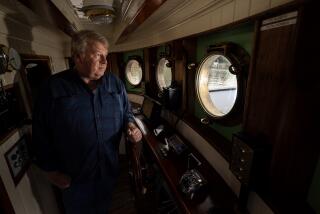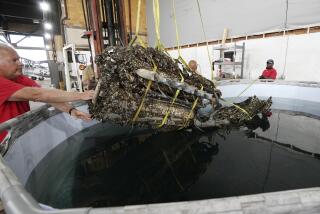Wrights’ Wrongs Fixed Via Computer as Team Builds Replica of Flyer
- Share via
Had there been a computer to analyze the marginal aerodynamics of it all, had a free-flight wind tunnel been available to show that their flying machine was prone to fatal spirals, if a modern dynamometer could have measured the sorry oomph of their 12-horsepower engine . . . well, the Wright brothers would have had sense enough to know one thing.
Their airplane simply would not get off the ground.
Yet in 1903 it did. Thanks to good fortune compensating for a borderline design. Thanks to an operational requirement eminently satisfied by an elementary, flat, low, 12-second flight. And because the Wright Flyer was opposing a 27-m.p.h. head wind that December day at Kill Devil Hills near Kitty Hawk.
“Without that (wind) I don’t think they could have accelerated to flying speed,” said Fred Culick, professor of applied physics and jet propulsion at Caltech. “But with it, all they had to do was accelerate to 6 m.p.h. to reach flying speed.
“I don’t think it could ever get out of ground effect (a cushion of air between the ground and a low-flying airplane) with the engine and the propellers they had. It was a very unstable airplane, very difficult to fly.”
Wind-Tunnel Tests
It should be noted that Culick’s view is somewhat more than personal opinion springing from the hindsight of modern technology. He is project engineer on a learned team (from the Los Angeles chapter of the American Institute of Aeronautics and Astronautics) that is using computers to dissect the pioneering of brothers Orville and Wilbur. They have built scale models and worked improvements on the Wrights’ original design. Soon they will have a full-scale model of the Wright Flyer mounted in the unrelenting environment of a wind tunnel.
And then, having corrected all the tiny wrongs that made two Wrights, they intend to build a flying version.
Culick, of course, will be the pilot.
Why? “Well, when you like airplanes you don’t really need to know why,” he said. Try again. “OK, I like to fly and there haven’t been too many people who flew the first airplane, right?”
Right. On the other hand, isn’t this a classic case of building a better bird cage? Or reinventing the wing? No, Culick said. The project is continuing what the Wright brothers would have done if they had today’s technology. Call it numerical archeology.
“We want to clarify what they did,” he said. “The primary purpose of a full-scale (flying) test is to do a complete documentary of the airplane.”
Culick, 52, also needs a flight test to confirm the accuracy of group research and development to date.
“And I emphasize ‘confirm,’ ” he said with a grin. “I hope we don’t confirm that what we’ve done is wrong.”
Culick, despite his 1961 doctorate in aeronautics and astronautics from the Massachusetts Institute of Technology, is a relatively new fan of the Wright brothers. He blames that on a streamlined educational process that succeeded in rooting his knowledge of aeronautical rudiments somewhere in the ‘20s.
Like many others, he even presumed the Wrights to be a couple of tinkering, doodling bicycle mechanics who somehow lucked their way into history.
Then, in 1977, while visiting the San Diego Air and Space Museum, he examined a replica of the Wright Flyer. He also obtained a copy of the Wrights’ collected papers covering their work from 1899 gliders to the production aircraft of 1909.
“I really was amazed when I read that first paper and suddenly realized that they were technically very astute,” Culick said. “They only had high school educations . . . but it was clear that
they innovated a great deal, that they were very thoughtful.
“They started out from zero, read all the literature, made a proper literature search, then took off from there. The first important event was noting--Wilbur noted it really--that birds twisted their wings for roll control.
“He (Wilbur) was making good observations and interpreting them precisely. They had very keen powers of observation, good reasoning, very good ideas, and they did everything just right with no tangents or sidetracking along the way.”
Their in-flight wing twisting, in fact, was aviation’s first aileron. The Wrights eventually learned, albeit the hard way, that anhedral, a downward arch to the wing, aggravates spiral instability and produces unstoppable, descending turns. Their propellers were rotating airfoils almost 50% more efficient than the crude air paddles of the competition.
“They flew for (a total of) 59 seconds in 1903,” Culick said. “It wasn’t until 1907 that someone else flew for a minute. So they were four years ahead of their time.”
Much more than stumblers, Culick concluded, the Wright brothers were spectacular achievers.
Replica Destroyed
In 1978, an arson fire munched most of the San Diego museum and all of the replica Flyer. An insurance settlement of $20,000 went to the Los Angeles chapter of AIAA that had built the airplane in 1953 to commemorate the golden anniversary of the Wright brothers’ flights. AIAA decided to use the money to build a replacement, but this time, an all-flying Flyer. A call for volunteers was made through the institute’s newsletter and member Howard Marx of Northrop.
“I called and told ‘em it was a great idea and I’d like to be part of it,” Culick said. “If I could be the test pilot.”
The group has grown to include engineers, retired military officers, airline captains and scientists. Bud Chamberlain, a former Air Force pilot. Bill Sparks, retired from Westinghouse. Henry Jex of Systems Technology Inc. Carl Friend, once of Lockheed, is handling rigging and stress analysis. Fred Erb, retired from Northrop, is coordinating construction for workers like Chuck Thomas, once with RCA and Lockheed.
And Culick, Marx, Sparks and Chamberlain are on the roster as test pilots one through four.
Interest has ebbed and flowed . . . work parties at a 1,500-square-foot warehouse are mostly on weekends, but not every Saturday and Sunday. Careers and family commitments usually come first.
But the work has sustained. Two scale models have been “flown” in Caltech’s wind tunnel and one, a stainless steel version with a 5-foot wing span, survived a simulated flight at 300 m.p.h. The full-scale replica is ready for its covering of Pima cotton. Next will be a wind-tunnel program when this big Flyer is bolted to its own power (a modified Volkswagen engine) in exploration of slipstream disturbances.
Yet another full-scale version will be built from this.
And then a Wright Flyer will putter and clatter aloft again and make its first flight in 83 years.
“We are not going to be doing any sustained flying,” said Culick. “We’ll do a few demonstrations, just take off and land . . . and be left with a couple of airplanes to put in a museum. Plus the documentation, of course.”
Close to Authentic
Despite the Bug in its tail, the AIAA Flyer will be much closer to an authentic flying machine than the supposedly genuine Wright Flyer that’s dangling in the Smithsonian Institution’s Air and Space Museum.
Although descended from the Wright Flyer, the Smithsonian’s airplane is only 40% real. The original made only four flights before being blown over and wrecked at Kitty Hawk. The pieces were hauled back to the Wright bicycle shop at Dayton, Ohio, where they were further damaged by a flood.
Sometime before World War I, the remains were obtained and rebuilt by the Massachusetts Institute of Technology. Then the Science Museum in London borrowed the completed hybrid, put it in safe hiding during World War II and then transferred it to the Smithsonian.
“So there is no original around that could fly again,” said Culick. “Even the one they flew for that television movie, ‘The Winds of Kitty Hawk,’ had a fake tail.” From the work to date, Culick and cohorts feel they have learned precisely where the Wrights erred and where their design was on the money.
The Flyer’s forward-facing rudders were too small and provided minimal directional stability. The airplane’s center of gravity was set too far to the rear for a further decrease of equilibrium. There was the anhedral and a highly cambered airfoil that created severe pitching.
Yet what the Wrights lost on the theoretical swings they made up on the technical roundabouts by their knowledge and ingenuity of aircraft controls and interactions.
In other words, Culick said, they knew much about controlling unstable devices, such as their bicycles and the first airplane, but little about inherent stability.
“Nobody did, in fact,” he said. “What they understood was equilibrium, but what they didn’t understand was what happened when you changed the angle of attack (the angle between an airfoil and air flow) of the airplane and upset that equilibrium.”
Then there was the engine.
“They designed and built their own engine and the thing weighed 10 pounds per horsepower. That meant marginal power to get out of ground effect at full power and just enough thrust to counteract the drag of the airplane. Langley (American physicist Samuel Langley) had an engine that weighed four pounds per horsepower. So there were engines around that were much better.”
‘Good Enough’
But again, a highly efficient propeller offset a rather inefficient engine. And when all was said and flown, “it was not a very good airplane by modern handling standards,” said Culick, “but it clearly was good enough.”
To make it better, he said, the AIAA Flyer will use a thicker airfoil. Construction will be strengthened by more and stronger brackets and some steel ribs. The rudders will be as much as 15% larger and the center of gravity will be moved forward.
“The changes we’re making are not noticeable, unless you know what you’re looking for,” Culick said. “But if the Wright brothers could see them, they would agree, no doubt about it.”
And, he said, there is one area of the project where new California technology has already failed to overtake old Ohio know-how: “We set out more than seven years ago with dozens of people, to do by committee what the Wright brothers alone did in less than four years. And we still haven’t flown our Flyer.”
More to Read
Inside the business of entertainment
The Wide Shot brings you news, analysis and insights on everything from streaming wars to production — and what it all means for the future.
You may occasionally receive promotional content from the Los Angeles Times.










